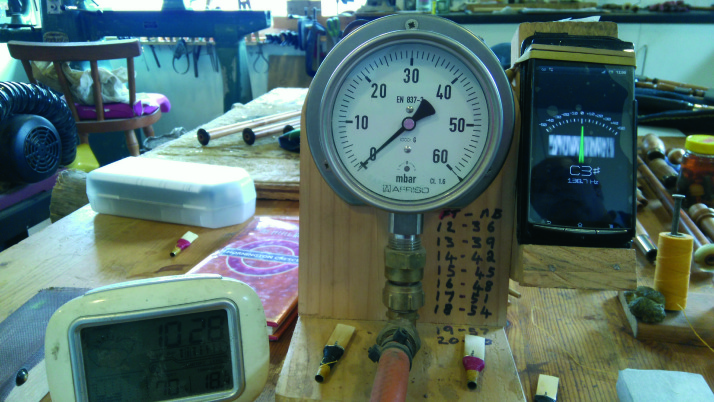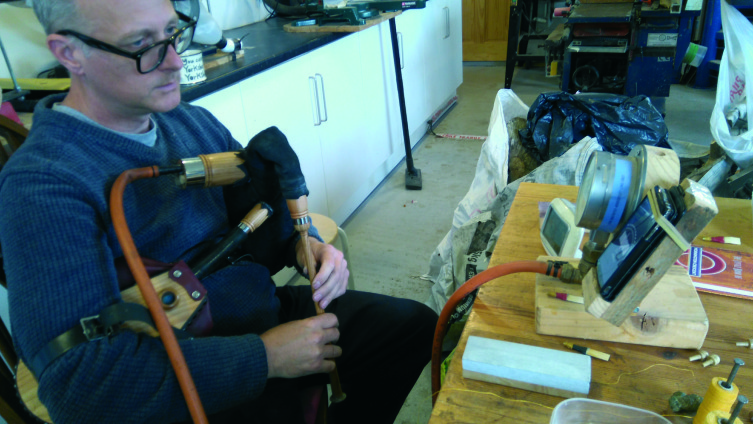The Bagpipe Society
Tools of the Trade
I first encountered bellows smallpipes in the late 80s at the Holmfirth Folk Festival. On the Saturday there was an open stage bagpipe event. The variety wasn’t on the scale of The Blow Out, but this was my introduction to one of the main bagpipes of the British Islands. Among the Northumbrian, Union, and Highland pipes, someone was playing a set of highland fingered smallpipes. I fell in love with the open, almost Northumbrian type sound, and the fingering was the same as I had learned as an eight year old at my local pipe band in Port Glasgow. This event inspired me to take up my out of tune practice chanter and start playing again. One Christmas, my dad unexpectedly took me up to a bagpipe shop on Blackfriars Street in Edinburgh, knowing I had previously been looking at their collection of smallpipes. I picked the ones that looked best in my ignorance, and fortunately they turned out to be a decent set. I was later told that they were an early set of Ian Kinnaird’s. So began my journey back into the bagpipe world.

For the first day, I pumped and pumped and then eventually managed to get through a tune, but with the sweat pouring out of me. After a year I wasn’t sweating as much, and the pipes began to feel part of me. I could knock out tunes ok, but just couldn’t get the tone—that beautiful steady buzzy drone sound, like a bumble bee on a summer’s day. Mine were more like an angry swarm ready to sting. After years and years of changing drone reeds for that elusive steady harmony, the penny eventually dropped. The reeds weren’t the problem, it was the piper. I just wasn’t blowing steadily enough. This sent me back to where I should have started. Instead of trying to play tunes, I should have been working on tone. Steady tone.
This now brings me to where I am now as a pipe maker. Some pipes require two pressures, one for the first octave and one for the second. There are even pipes that use pressure to bend notes for artistic effect, although they are usually the droneless Persian or Mediterranean type bagpipe. The pipes I make are highland fingered smallpipes (lowland and borderpipes,) they have just one octave and require just one pressure. In the setting up of my pipes, it is crucial that the pressure is kept at a constant, as your ears may start adjusting the pressure to bring the chanter into tune with the drones. For this I use a pressure gauge, ranging from zero to sixty millibars, with a tuner to check the pitch (I use an android phone app called Pitch Lab.) I also use a thermometer to check the temperature and hydrometer for humidity. It is important to check the room temperature with ‘cauld wind pipes’, as you don’t want the wind to be too cauld. The pitch will sharpen as temperature rises, the philharmonic society adopted A 439 hz at 20 degrees centigrade in 1896. 20 degrees is the temperature I aim for. These parameters allow me to tune my chanters with confidence that they are set at an absolute even pressure. It is possible to make your own manometer pressure gauge with a tube attached to a piece of board with measurements in inches marked on the side. There are also cheap gauges on eBay. You can plug the tube into a drone end. I use an adaptor that plugs into the drone stock in case I break a drone pin by accident.

The gauge is also useful when teaching steady tone. For beginners I find it best to hook them up and let them watch the gauge, and keep it as steady as they can. With more experienced players, I can turn the gauge away from them and let someone else monitor it. Most of us will be surprised with how bad our blowing can be. In the end, the gauge doesn’t lie.
http://www.lochalshpipes.co.uk/
- Data Processing Notice (GDPR)
@BagpipeSociety on X (formally known as Twitter)
TheBagpipeSociety on Instagram
 BagpipeSociety on Facebook
BagpipeSociety on Facebook
Something wrong or missing from this page? Let us know!
